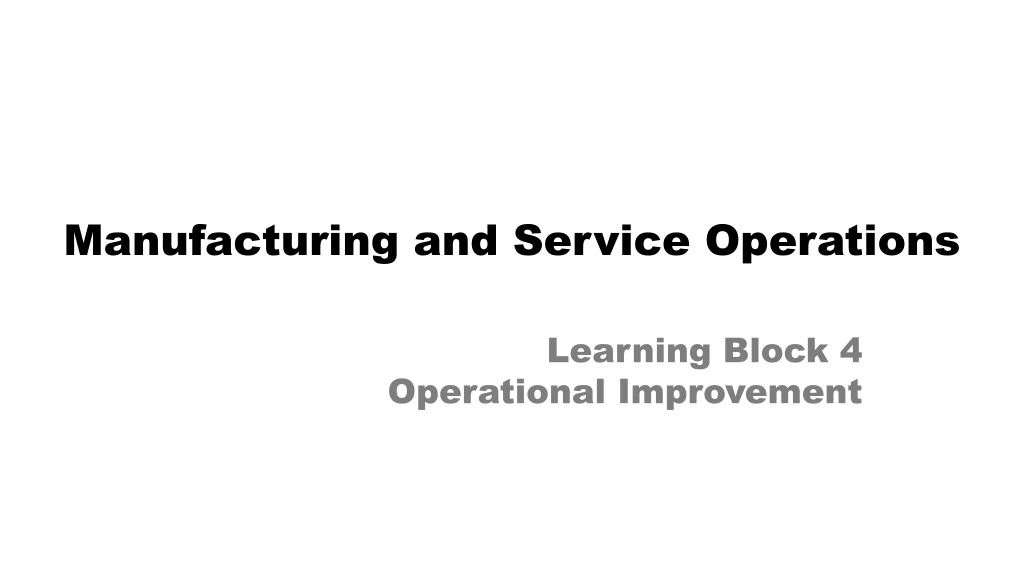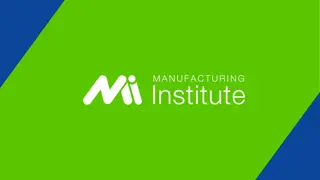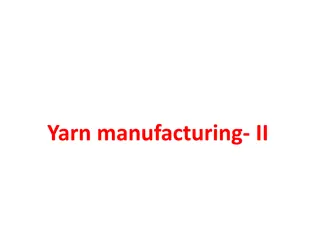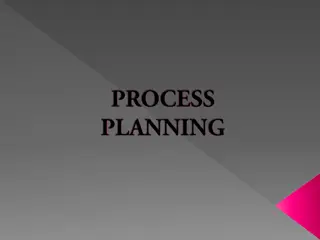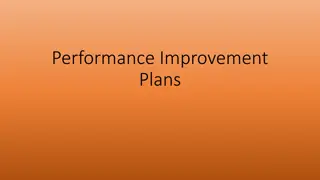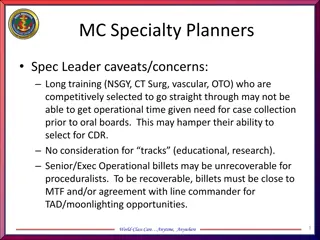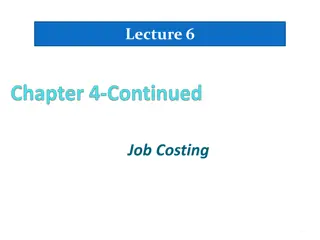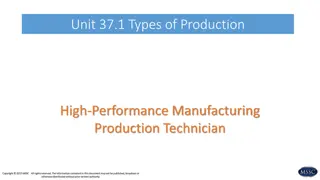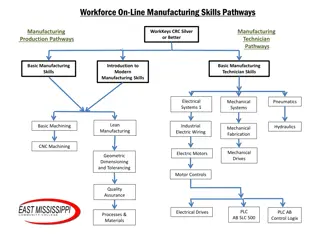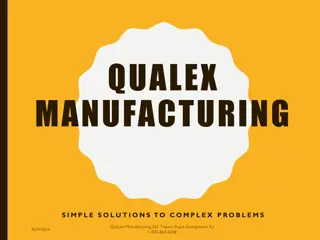Operational Improvement in Manufacturing and Service Operations
Businesses prioritize cost reduction to stay competitive by implementing continuous improvement strategies. This course covers Lean practices, quality improvement tools, and techniques to enhance operational efficiency and productivity.
Download Presentation

Please find below an Image/Link to download the presentation.
The content on the website is provided AS IS for your information and personal use only. It may not be sold, licensed, or shared on other websites without obtaining consent from the author. Download presentation by click this link. If you encounter any issues during the download, it is possible that the publisher has removed the file from their server.
E N D
Presentation Transcript
Manufacturing and Service Operations Learning Block 4 Operational Improvement
Course Agenda Course Agenda 1. Manufacturing and Service Operations Overview 2. Strategic Decisions in Manufacturing 3. Manufacturing Planning and Control 4. Operational Improvement 5. Performance Metrics 6. Systems and Technology 7. Maintenance and Quality 2
Learning Block Agenda Learning Block Agenda 1. Continuous Improvement 2. Lean 3. Quality Improvement Tools and Techniques
Description Description Businesses work to reduce costs to maintain competitiveness in their marketplace. Typically achieved through a consistent approach to continuous improvement No process is perfect, and improvements can be continuously realized. 4
Learning Objectives Learning Objectives Recognize the basics of the lean concept Understand the set of lean objectives, including flow, pull, striving for perfection, standardization, and simplification Apply the five important elements of lean production systems Analyze the set of lean tools and applications, including value stream mapping, process mapping, kaizen workshops, and the 5S improvement methodology Implement quality management and improvement tools and techniques, including design of experiments, process proving, SPC, and Six Sigma
Unit 1: Continuous Improvement Unit 1: Continuous Improvement To achieve competitiveness, companies focus on operational processes and practice continuous improvement. Companies seek opportunities to streamline work and reduce waste. Brainstorm to identify improvement opportunities Assess Plan the new process for achieving objectives the best approaches for revising work Implement the revisions and changes Figure 39. Closed-loop improvement process. Developed by LINCS in Supply Chain Management Consortium.
Unit 2: Lean Unit 2: Lean Lean is a business philosophy that emphasizes the relentless pursuit of waste reduction across an organization. Lean practices are generally oriented toward manufacturing operations. They can be applied to other business units within an organization as well. Figure 40. Lean process. Developed by LINCS in Supply Chain Management Consortium.
Five Principles of Lean Five Principles of Lean Specifiying value as defined by the customer Identifyingthevaluestreamthatcreates and deliversthevalue Working to ensure information, materials, and product flow to the customer Responding to demand only when there are clear signals to do so Relentlessly pursuing excellence
Lean Objectives Lean Objectives Six objectives underlie the lean philosophy: Flow Pull Strive for excellence Optimization Standardization Simplification
Lean Objectives Lean Objectives Keeping the right material moving toward supply chain partners Payment, information, human resources, and other types of flow are also critical. Interruption to any flow can create waste. Flow Relaying information from downstream entities to upstream operations No upstream activity occurs without a downstream request. Companies make decisions based on customer requests instead of forecasts. Pull Strive for Excellence Any deviation from a desired target carries an associated loss. The pursuit of zero defects is critical in a lean operation with minimal inventory.
Lean Objectives Lean Objectives Making something as perfect, effective, or functional as possible Optimization usually entails a reduction in waste. Optimization Relaying information from downstream consumers to upstream operations Failure to standardize may result in wasteful duplication of effort. Standardization Reducing scope or complexity without diminishing effectiveness Process and product design often benefit from simplification. Activities that don t add value are eliminated. Simplification
Elements of Lean Operations Elements of Lean Operations Setup Time Reduction Facility Layout Changes 5S Lean Pull Systems Level Scheduling Uniform Loading
Elements of Lean Operations Elements of Lean Operations Setup time reduction is the systematic process of minimizing resource downtime during changeovers. Setups are essentially non-value-adding activities that impede flow, which affects throughput, productivity, and capacity. Planning and staging also improves flow across operations. Entities anticipate when changes will occur and are prepared to perform the change as quickly as possible.
Elements of Lean Operations Elements of Lean Operations Physical facility layouts can constrain flow, so companies may pursue facility layout changes to target areas of improvement. An inefficient layout often leads to excessive material handling and movement between work centers. Benefits may include reductions in cycle times, work-in-process inventory, and floor space requirements.
Elements of Lean Operations Elements of Lean Operations In a pull system, no upstream activity occurs without a request from a downstream entity. Visible signals, or kanbans, provide visual triggers that provide authorization and instruction to upstream entities. 1. Work Center 2 (the downstream work center) uses material that was requested earlier from Work Center 1 (the upstream work center). The C card that was attached to the load is removed and placed in a kanban post. A C card that is not attached to material is a trigger to retrieve more material. An employee goes to the temporary holding area between the work centers with the C card. At the holding area the employee removes the P card from the load and inserts the C card. The load with the newly inserted C card is moved to Work Center 2, where the material is needed. The P card that was removed in Step 2 is sent to the kanban post in Work Center 1. The P card at the kanban post triggers production of the material and in the quantity listed on the card. The P card is attached to material in a returnable container and moved to a temporary holding area to await an employee to arrive with a C card to retrieve the material. 2. 3. 4. 5. 6. Figure 44. Two-card Kanban system. Developed by LINCS in Supply Chain Management Consortium.
Elements of Lean Operations Elements of Lean Operations The entire production process must be coordinated to maintain uniform loading a steady flow of material without inventory shortages or accumulation. Requires the sharing of demand information among work centers and supply chain partners. Critical for avoiding the bullwhip effect, which demonstrates how minor fluctuations in downstream demand amplify further upstream due to a lack of clear communication.
Elements of Lean Operations Elements of Lean Operations Level scheduling involves scheduling a similar product mix every day during a given period. Most appropriate for companies with consistent demand patterns and limited product offerings. The challenge is to set up a production process that is synchronized to the takt time, or the rate at which customers demand a product.
Elements of Lean Operations Elements of Lean Operations 5S is a Japanese lean methodology designed to reduce waste and optimize productivity through better workplace organization. 1. 2. Sort (Seiri): Identify and divide items into retain, return, or eliminate Set in Order (Seiton): Create a place for all items needed: organize, arrange, and store material, equipment, and supplies. Shine (Seiso) : Create a work area that is clean, well lit, and organized Standardize (Seiketsu): Make the 5S process an habitual part of everyday work Sustain (Shitsuke): Ongoing application of the knowledge and skills learned from the 5S process, applied across the organization 3. 4. 5. Figure 48. 5S. Developed by LINCS in Supply Chain Management Consortium.
Unit 3: Quality Improvement Tools and Unit 3: Quality Improvement Tools and Techniques Techniques Quality improvement tools and techniques can be divided into two categories. Product and Process Design Focus: Eliminate Process Variability Concurrent product and process design Steady State Focus: Maintain Process Stability Statistical process control Early supplier and customer involvement Pre-control Quality function deployment Value analysis Design for assembly/manufacturability Quality improvement teams Process proving studies (Cpk) Kaizen techniques Design of experiments Continuous improvement processes and measurement Value Engineering
Approaches to Quality Management Approaches to Quality Management Statistical Process Control (SPC) is the application of statistical methods to identify and control the special causes of variation in a process. The primary tool for determining whether a previously proven process remains consistent and in control SPC cannot determine why a process is out of control. SPC typically relies on constant data collection and statistical charting.
Approaches to Quality Management Approaches to Quality Management Six Sigma methodology seeks to improve quality by identifying and removing defects and by minimizing variability in business processes. Typically implemented through projects that follow a defined sequence of steps and have specific value targets: Reducing process cycle time Reducing defects Reducing costs
Approaches to Quality Management Approaches to Quality Management The DMAIC methodology is a key feature of Six Sigma techniques. Define Measure Analyze Improve Control
Approaches to Quality Management Approaches to Quality Management Define the customer, their critical-to-quality issues, and the core business process involved Define Define the boundaries of the improvement project Define the process to be improved by mapping the process flow Identify the customers of the process and their requirements and expectations Measure the performance of the business process involved Measure Develop a data collection plan Collect data from many sources to determine types of defects and metrics Compare to customer feedback to determine shortfalls Analyze both the data collected and the process map to identify root causes of defects and improvement opportunities Analyze Identify gaps between current and desired performance Prioritize improvement opportunities Identify sources of variation Improve the process by designing creative solutions to eliminate defects root causes Improve Create innovative solutions using technology and advanced tools Develop and deploy an implementation plan Control the process to ensure improvements are maintained Control Prevent reverting back to previous methods Develop, document, and implement an ongoing monitoring plan Institutionalize the improvements through the modification of systems and structures
Summary Summary
Practice Questions Practice Questions 1. The D is the first step in the DMAIC improvement process and is an abbreviation for: a. Determine b. Define c. Decide d. Delineate 2. Which of the following is true about SPC charting? a. Charts are used to correct product deficiencies b. SPC charts tell an operator how to correct a problem c. Charts can indicate that a process is out of control d. SPC charting signals an operator when a process is trending out of control
Practice Questions Practice Questions 3. Six Sigma techniques are most closely aligned with: a. Product design b. Production time standards c. Facility design d. Quality management 4.The 5S methodology is designed to reduce waste and optimize productivity through: a. Better workplace design b. Product design c. Product sustainability d. Optimizing transportation
Practice Questions Practice Questions 5. What is the first area that companies usually address to make their internal operations lean? a. Facility layout changes b. Level scheduling c. Pull systems d. Setup reductions 6. Companies practice continuous improvement initiatives to: a. Fill gaps during process changeovers b. Satisfy management initiatives c. Streamline work and reduce waste d. Follow established procedures
Practice Questions Practice Questions 7. Which choice best describes a kanban? a. The flow rate of work into a work center b. A chart showing if production is staying in control c. A continuous improvement workshop d. An authorization and instruction from a downstream center for production or withdrawal of items from an upstream center in a lean supply chain 8. In a two-card kanban system, what is a C card? a. It is a conveyance card that triggers the movement of material from one work center to another b. It is a conveyance card that triggers the production of an item c. It is a control card designed to introduce discipline into a work center d. It is a control card that triggers the movement of material from one work center to another
Practice Questions Practice Questions 9. What is the lean element that allows a steady and balanced flow of material to move through a facility or across a supply chain, with no shortages in inventory? a. Level scheduling b. Uniform loading c. Uniform scheduling d. Level loading 10. In lean operations, what is the rate at which customers demand a product? a. Flow time b. Order cycle time c. Takt time d. Throughout time
